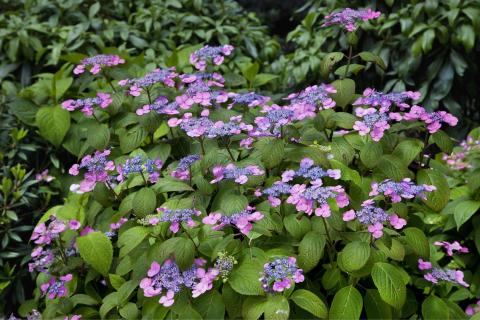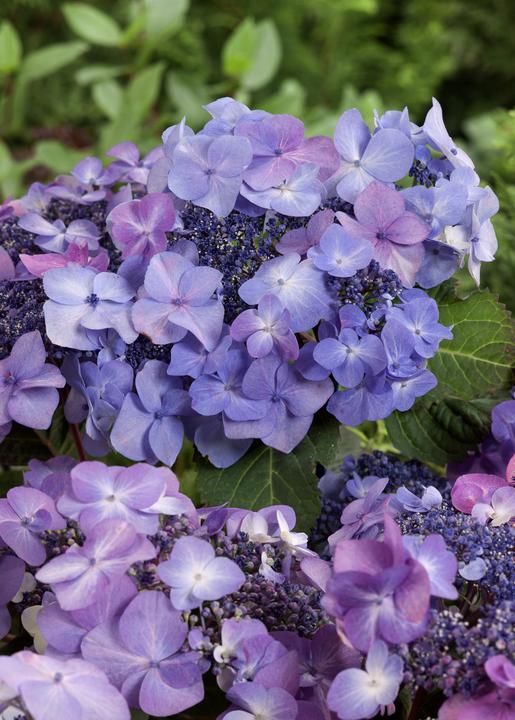Mountain Hydrangea, Tea of Heaven
Mountain Hydrangeas are almost outdone by their large-flowered relatives, the Bigleaf Hydrangea. They look a lot more natural and also have something to offer the insect world.
Factsheet
- Growth type
-
- half shrub
- Growth height (from)
- from 100 cm to 150 cm
- Growth width (from)
- from 100 cm to 150 cm
- Growth characteristics
-
- sweeping
- foothills
- bushy
- Flower color
-
- purple
- blue
- pink
- white
- multicolored
- Flowering time (month)
-
- July to October
- Flower shape
-
- Umbrella panicles
- Leaf color
-
- green
- page format
-
- ovate
- pointed
- Light
-
- sunny to semi-shade
- Soil type
-
- sandy to loamy
- Soil Moisture
-
- moderately humid to humid
- ph value
-
- neutral to weakly acidic
- Lime compatibility
-
- sensitive to lime
- Nutrient requirements
-
- nutrient-rich
- Humus
-
- rich in humus
- Decorative or utility value
-
- Flower Decoration
- picturesque growth
- Nectar or pollen plant
- Winter Hardness
-
- hardy
- Use
-
- Flowerbeds
- Bouquets
- Single position
- Group planting
- Planters
- Garden style
-
- cottage garden
- Flower garden
- Formal garden
- patio
- Park area
- Pot garden
- Bee Friendly
- bee friendly plant
The wild ancestors of Hydrangea serrata are native to the mountain forests of the Japanese islands. That’s why they’re also known as Mountain Hydrangeas. They grow in rainy locations at altitudes of around 3200 feet on raw humus soil. Hydrangea serrata ‘Oamacha’, for example, is a fairly original cultivar. The Korean Mountain Hydrangea (Hydrangea serrata f. koreana) is a close relative and can be found in very similar locations on the Korean Peninsula. It is also available in garden centers as a wild variety, whereas you tend to only find cultivars of the Japanese Mountain Hydrangea such as ‘Bluebird’. Furthermore, there are now numerous Mountain and Bigleaf hydrangea hybrids (Hydrangea macrophylla), which are often also referred to as Mountain Hydrangeas. One of the best known is the variety ‘Preziosa’ – like the Bigleaf Hydrangeas, the inflorescences are predominantly sterile, but significantly smaller.
The term "lacecap" aptly describes the special structure of the inflorescences with fertile inner flowers. Lacecap Hydrangeas are classified as Bigleaf Hydrangeas, but, due to the intensive cross breeding of the two species, amateur gardeners are barely able to distinguish them from true Mountain Hydrangeas. That’s why many gardeners use the name Mountain Hydrangea for all Hydrangeas with this distinctive inflorescence – irrespective of whether they more closely resemble Hydrangea macrophylla or Hydrangea serrata.
Mountain Hydrangeas have a slightly more compact growth habit than Bigleaf Hydrangeas and rarely grow more than 40 to 60 inches tall. However, they can expand significantly with age – the Korean Mountain Hydrangea even forms runners. The loosely upright main branches have an ocher brown to reddish-brown bark, the older wood peels off in stringy strips. The current season’s shoots are green and the leaf nodes have a somewhat reddish tone. Like Bigleaf Hydrangeas, Mountain Hydrangeas are subshrubs – this means that the shoot tips do not lignify and tend to die back in winter.
The leaves are deciduous and like all Hydrangeas, grow opposite each other. They are ovate and remarkably pointed, around four inches long and three inches wide. This means that they are slightly smaller than the similarly shaped leaves of bigleaf hydrangeas. The leaves have a very weak fall coloring, or none at all.
Mountain Hydrangeas have lacecap flowers. They have an outer rim of sterile mock flowers, which attract insects with their striking flower colors. At the center of each flower head are fertile flowers with colored stamens. For many varieties, depending on the soil reaction, both they and the showy flowers are able to change their color. The flowers appear between July and October. They are blue in acidic soils and pink in neutral to alkaline soils. Depending on the variety, the flowers have a diameter of 2.36 to 3.94 inches. Even after they fade, the seed heads of Mountain Hydrangeas remain very beautiful well into winter.
In terms of location, Mountain Hydrangeas have the same requirements as Bigleaf Hydrangeas. They grow best in slightly sheltered spots with full sun to partial shade, they are however a little more frost-hardy than their relatives. They are therefore better able to cope with exposed locations. The flowering shrubs develop best in low-lime, evenly moist, humus-rich soils with a pH between 5 and 7. They need plenty of water in strong sunlight, otherwise the leaves quickly go limp. The leaves of the plants often turn a slightly reddish color in the sun, especially when they aren’t getting enough water.

The best time to plant Hydrangeas is between March and June. This gives the plants enough time to become well-established before the onset of winter. Make sure to thoroughly prepare unfavorable, loamy, low-humus soils by working plenty of sand, bark humus, leaf humus, or special rhododendron soil into the upper 7.87 to 11.81 inches. Hydrangeas should be planted deep enough for the root ball to be roughly at ground level. Thoroughly water the plants afterwards and sprinkle a few handfuls of horn shavings around the root area. Then cover the ground surface with bark mulch so that the soil does not dry out easily. It’s very important that they have plenty of water after planting. It’s best to water them with rainwater or groundwater with a low lime content. You can use tap water, provided that it is not too hard (no more than 178 mg/L).
With all Hydrangeas, you should avoid using compost, since conventional garden compost normally contains too much salt and lime for the flowering shrubs. After pruning in spring, you should instead fertilize your Mountain Hydrangeas regularly with horn shavings or with a commercial rhododendron or hydrangea fertilizer. Specialist stores have a variety of special fertilizers which can turn Hydrangeas blue. They usually contain alum, a special aluminum salt that is absorbed by the Hydrangea in larger quantities in acidic soils and turns the flowers blue.
Thanks to their compact size, Mountain Hydrangeas are great for growing in tubs. However, it is important that the plants are not left in the midday sun in summer and have plenty of water. The pot should also hold a large amount of soil so that the substrate does not dry out too quickly. It’s also important that potted Hydrangeas have a regular supply of nutrients. During the season, it’s best to fertilize the flowering shrubs by adding liquid azalea or Hydrangea fertilizer to their water every two weeks.
Mountain Hydrangeas are pruned in exactly the same way as Bigleaf Hydrangeas: In early spring, only remove the old flowers and frozen branches. Cut off old flowers directly above the next well-developed pair of buds. In many of these buds, the fully developed flowers for the new season are already snoozing. In contrast to Bigleaf Hydrangeas, there are only a few reblooming varieties of true Mountain Hydrangea, such as ‘Twist’n Shout’. However, it is strictly speaking not a true Mountain Hydrangea, but a hybrid and belongs to the ‘Endless Summer’ range. Therefore, hard pruning is generally not recommended, unless you want to go without flowers for an entire season. However, it’s fine to thin out shrubs that have become too dense.
Mountain Hydrangeas are slightly more robust than Bigleaf Hydrangeas, but still not completely frost-hardy. Therefore, to be on the safe side during harsh winters in unprotected locations, you should cover the shrubs with a thick layer of leaves and fir tree branches. Potted plants also need very good winter protection if you want to overwinter them outdoors. You should move the pots to a sheltered location, close to the walls of the house, where the plants can not be affected by cold easterly winds.
Mountain Hydrangeas are very versatile, as they do not look too dominant with their very natural flowers. They look good alongside matching varieties of almost all shrubs that grow in shade or partial shade and, of course, other Hydrangeas. It’s generally best to plant the delicate Mountain Hydrangeas in groups so that they can truly shine. Single plants are often a little lost in flower beds. The Korean Mountain Hydrangea (Hydrangea serrata f. koreana) provides groundcover with its runners and looks beautiful under deciduous trees with tolerant roots. All species and varieties of rhododendron make good plant partners – after flowering in summer, they look a little less sad when interspersed with flowering mountain hydrangeas, and their dark green foliage forms a nice, calm backdrop to the beautiful flowers.
Mountain Hydrangeas are the first choice for nature gardens, as their fertile, pollen-rich flowers attract insects. As potted plants, their flowers spruce up shaded to partially shaded patios and balconies.
There is now a wide selection of varieties of the Mountain Hydrangea and hybrids with various flower colors and characteristics:
‘Acuminata’: compact growth, 2.36 to 3.15 inches wide pinkish white to pale purple panicles
‘Bluebird’: oldest and most well-known variety and remains one of the most beautiful, large-flowered with a flower diameter of 3.94 inches and a reliable blue bloomer in acidic humus-rich soils with intensely colored stamens, 3 to 5 foot tall
‘Charm’: fast-growing, large-flowered hybrid with inflorescences up to 7.87 inches and an interesting reddish-white color. Up to 71 inches tall and rather like a Bigleaf Hydrangea
‘Preziosa’: Hybrid with small, mostly sterile flowers with an intense magenta to purple color, faster growing than true mountain hydrangeas, at least 5 ft tall
‘Rosalba’: Dwarf variety, only 28 to 47 inches tall, well-suited to tubs, inflorescences with a diameter of 3.15 inches, only a few showy sterile flowers with a white to pink color, a beautiful contrast to the purple-blue stamens
‘Twist’n’ Shout’: Hybrid with pink to blue panicles up to 3.94 inches in size, reblooming, up to 5 ft tall
Mountain Hydrangeas are very easy to propagate from cuttings. They reliably form roots when you put semi-hardwood cuttings with no flowers into humus-rich, evenly moist potting soil in June or July. Leave only one pair of leaves on each cutting and cut the leaves crosswise to reduce the evaporation surface area and make better use of the space in the propagator. The first roots form after only two weeks in locations that are warm and bright, but not too sunny.
When planted in the right location, Hydrangeas are very robust and rarely troubled by pests. Aphids and vine weevils occasionally cause the plants problems. Mountain Hydrangeas kept indoors or in conservatories with dry, heated air are susceptible to spider mites. Powdery mildew is one of the most common diseases. Leaves turn yellow – known as chlorosis –when the soil is too limey. If the leaf veins remain green, the plant isn’t able to absorb enough iron due to the high pH (lime-induced chlorosis). In this case, work some Rhododendron soil into the ground and fertilize the leaves with a special iron fertilizer (such as "Wuxal") according to the instructions on the packet to relieve acute symptoms of deficiency.





